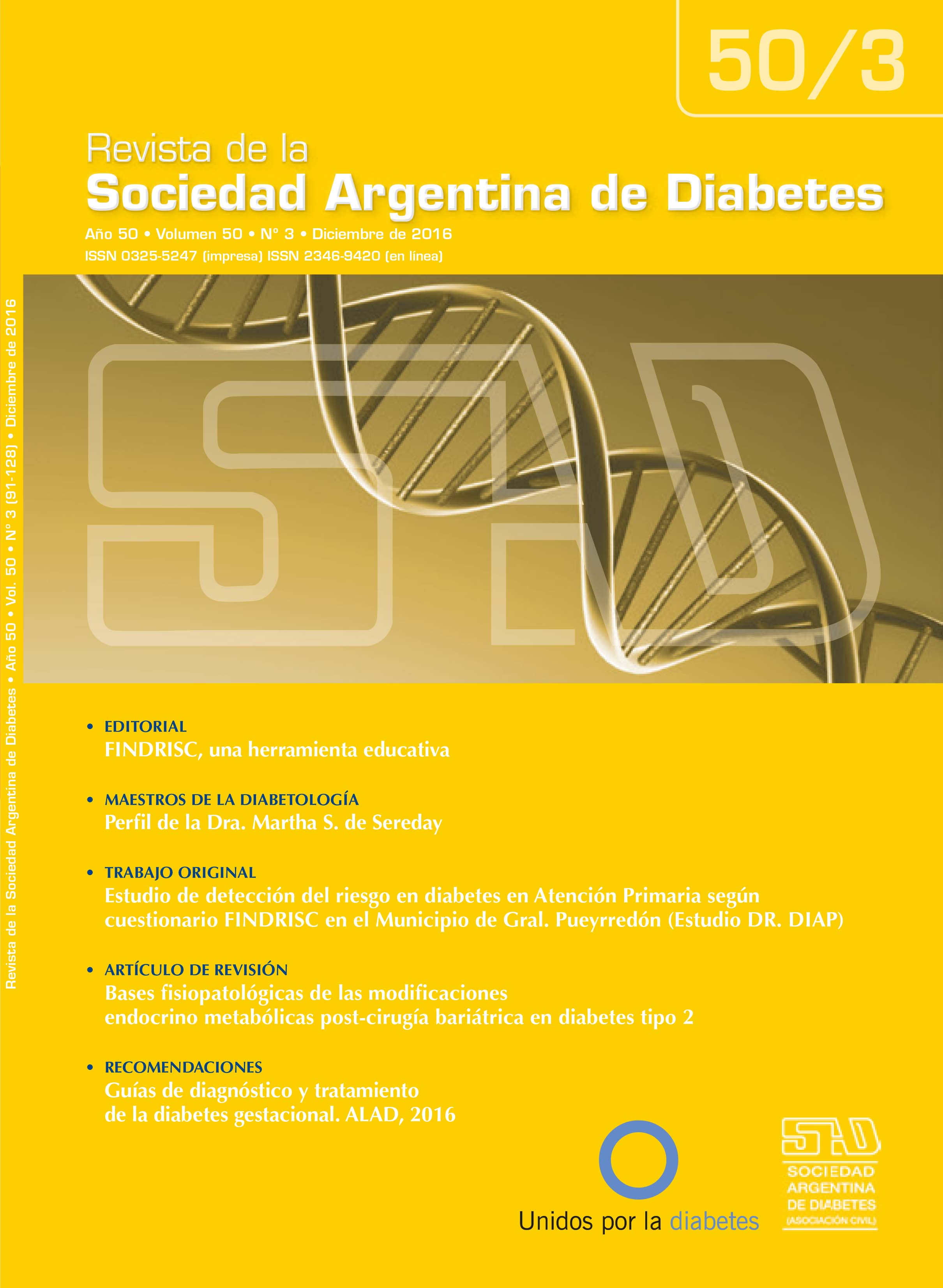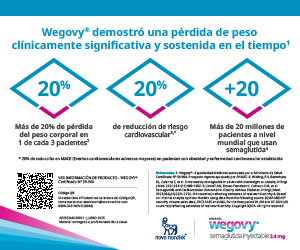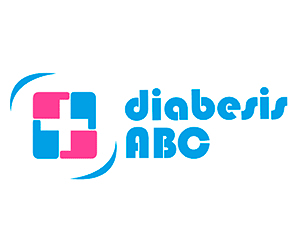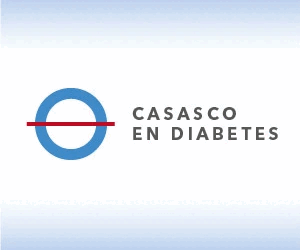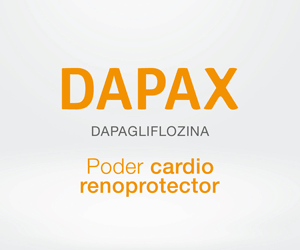Bases fisiopatológicas de las modificaciones endocrino metabólicas post-cirugía bariátrica en diabetes tipo 2
DOI:
https://doi.org/10.47196/diab.v50i3.44Palabras clave:
cirugía bariátrica, obesidad, derivación gástrica, diabetes mellitusResumen
Cuando la diabetes mellitus tipo 2 (DM2) se asocia a obesidad mórbida, frecuentemente la eficacia a largo plazo de las intervenciones terapéuticas no logran los objetivos ni disminuyen el riesgo cardiovascular o las complicaciones crónicas. Datos emergentes postulan a la cirugía bariátrica como tratamiento efectivo para la obesidad y sus comorbilidades.
El objetivo del presente trabajo es investigar sobre esta nueva alternativa terapéutica de la DM2 analizando desde la fisiopatología hasta los predictores de suceso y fracaso en los resultados post-quirúrgicos.
La reorganización intestinal post-quirúrgica produciría modificaciones hormonales en los ácidos biliares, sensado de nutrientes, microbioma intestinal, incretinas y anti-incretinas, asignándose un rol clave como responsable de los efectos normoglucemiantes. No obstante, la fisiología y los mecanismos moleculares subyacentes aún no se comprenden totalmente. Numerosos ensayos clínicos aleatorios a corto/mediano plazo demuestran que la cirugía metabólica logra un excelente control glucémico y reduce factores de riesgo cardiovascular. Aunque se necesitan estudios adicionales para demostrar beneficios a largo plazo, existe suficiente evidencia que apoya su inclusión entre las intervenciones contra la DM2. Una mejor comprensión de esta constelación de factores que intervienen en la homeostasis glucémica abre el camino hacia potenciales dianas terapéuticas, incluyendo drogas específicas, técnicas menos invasivas, optimización de los resultados quirúrgicos y fundamentalmente promover una mayor individualización de la terapia en la DM2.
Citas
Whiting DR, Guariguata L, Weil C, et al. IDF diabetes atlas: global estimates of the prevalence of diabetes for 2011 and 2030. Diabetes Res Clin Pract 2011; 94:311-321.
Gregg EW, Chen H, Wagenknecht LE, et al. Look AHEAD Research Group. Association of an intensive lifestyle intervention with remission of type 2 diabetes. JAMA 2012; 308:2489-2496.
Álvarez MG, Fuentes S, Mociulsky J, y col. Actualización de cirugía bariátrica y cirugía metabólica. Revista de la Sociedad Argentina de Diabetes 2013; 47:69-80.
Mingrone G, Panunzi S, De Gaetano A, et al. Bariatric surgery versus conventional medical therapy for type 2 diabetes. N Engl J Med 2012; 366:1577-1585.
Dorman RB, Serrot FJ, Miller CJ, et al. Case matched outcomes in bariatric surgery for treatment of type 2 diabetes in the morbidly obese patient. Ann Surg 2012; 255:287-293.
Dixon JB, Zimmet P, Alberti KG, et al. International Diabetes Federation Taskforce on Epidemiology and Prevention, Bariatric surgery: an IDF statement for obese type 2 diabetes. Surg Obes Relat Dis 2011; 7:433-447.
World Health Organization. Definition, diagnosis and classification of diabetes mellitus and its complications. Reports of a Who consultation. Part 1: Diagnosis and classification of diabetes mellitus. Genève: World Health Organization: 1999.
De Fronzo RA. Lilly Lecture: The triumvirate: cell, muscle, liver: a collusion responsible for NIDDM. Diabetes 1988; 37:667-687.
Larsen N, Vogensen FK, Van Den Berg FW, et al. Gut microbiota in human adults with type 2 diabetes differs from non-diabetic adults. PLoS ONE 5 2010; 9085.
Cone JJ, McCutcheon JE, Roitman MF. Ghrelin acts as an interface between physiological state and phasic dopamine signaling. J. Neurosci 2014; 34: 4905-4913.
Inzucchi SE, Bergenstal RM, Buse JB, et al. Management of hyperglycemia in type 2 diabetes: a patient-centered approach: position statement of the American Diabetes Association (ADA) and the European Association for the Study of Diabetes (EASD).Diabetes Care 2012; 35:1364-1379.
Stratton IM, Adler AI, Neil HA, et al. Association of glycaemia with macrovascular and microvascular complications of type 2 diabetes (UKPDS 35): prospective observational study. BMJ 2000; 321:405-412.
King P, Peacock I, Donnelly R, et al. The UK Prospective Diabetes Study (UKPDS): clinical and therapeutic implications for type 2 diabetes. British Journal of Clinical Pharmacology 1999; 48(5):643-648.
Gæde P, Vedel P, Parving H-H, Pedersen O. Intensified multifactorial intervention in patients with type 2 diabetes and microalbuminuria: The Steno Type 2 randomised study. N Engl J Med 2003; 348: 383-93.
Knowler WC, Barrett-Connor E, Fowler SE, et al. Diabetes Prevention Program Research Group (DPP). Reduction in the incidence of type 2 diabetes with lifestyle intervention or metformin. N Engl J Med 2002; 346:393-403.
Joshua P, Cummings T, Cummings D. Minireview: hormonal and metabolic mechanisms of diabetes remission after gastrointestinal surgery. Endocrinology 2009; 150:2518-2525.
Cummings DE, Flum DR. Gastrointestinal surgery as a treatment for diabetes. JAMA 2008; 299:341-343.
Chambers AP, Smith EP, Begg DP, et al. Regulation of gastric emptying rate and its role in nutrient-induced GLP-1 secretion in rats after vertical sleeve gastrectomy. Am J Physiol Endocrinol Metab 2014; 306: 424-432.
Laferrere B, et al. Effect of weight loss by gastric bypass surgery vs hypocaloric diet on glucose and incretin levels in patients with type 2 diabetes. J Clin Endocrinol Metab 2008; 93:2479-2485.
Martinussen C, Bojsen-Møller KN, Dirksen C, et al. Immediate enhancement of first-phase insulin secretion and unchanged glucose effectiveness in patients with type 2 diabetes after Roux-en-Y gastric bypass. Am J Physiol Endocrinol Metab 2015; 308:E535-E544.
Falken Y, Hellström PM, Holst JJ, Näslund E. Changes in glucose homeostasis after Roux-en-Y gastric bypass surgery for obesity at day 3, 2 months, and 1 year after surgery: role of gut peptides. J Clin Endocrinol Metab 2011; 96:2227-2235.
Le Roux CW, et al. Gut hypertrophy after gastric bypass is associated with increased glucagon-like peptide 2 and intestinal crypt cell proliferation. Ann Surg 2010; 252:50-56.
Andreelli F, Amouyal C, Magnan C, et al. What can bariatric surgery teach us about the pathophysiology of type 2 diabetes? Diabetes & Metabolism 2009; 35: 499-507.
Romero F, Nicolau J, Flores L, et al. Comparable early changes in gastrointestinal hormones after sleeve gastrectomy and Roux-En-Y gastric bypass surgery for morbidly obese type 2 diabetic subjects. Surg Endosc 2012; 26:2231-2239.
Seeley RJ, Chambers AP, Sandoval DA. The role of gut adaptation in the potent effects of multiple bariatric surgeries on obesity and diabetes. Cell Metabolism 2015; 21.
Alfa RW, Park S, Skelly KR, et al. Suppression of insulin production and secretion by a decretin hormone. Cell Metab 2015; 21:323-333.
Sandler BJ, Rumbaut R, Swain CP, et al. Human experience with an endoluminal, endoscopic, gastrojejunal bypass sleeve. Surg Endosc 2011; 25:3028-3033.
Cavin JB, Couvelard A, Lebtahi R, et al. Differences in alimentary glucose absorption and intestinal disposal of blood glucose after Roux-en-Y gastric bypass vs sleeve gastrectomy. Gastroenterology 2016; 150:454-464.e9.
Scarlett JM, Schwartz MW. Gut-brain mechanisms controlling glucose homeostasis. F1000 Prime Rep 2015; 7:12.
Depoortere I. Taste receptors of the gut: emerging roles in health and disease. Gut 2014; 63:179-190.
Kohli R, Bradley D, Setchell KD, et al. Weight loss induced by Roux-en-Y gastric bypass but not laparoscopic adjustable gastric banding increases circulating bile acids. J Clin Endocrinol Metab 2013; 98: 708-712.
Arble D, Sandoval D, Seeley RJ. Mechanisms underlying weight loss and metabolic improvements in rodent models of bariatric surgery. Diabetología 2015; 58:211-220.
Li J, Ashrafian H, Bueter M, et al. Metabolic surgery profoundly influences gut microbial-host metabolic cross-talk. Gut 2011; 60:1214-1223.
Graessler J, Qin Y, Zhong H, et al. Metagenomic sequencing of the human gut microbiome before and after bariatric surgery in obese patients with type 2 diabetes: correlation with inflammatory and metabolic parameters. The Pharmacogenomics Journal 2013; 13: 514-522.
Liou AP, Paziuk M, Luevano JM Jr, Machineni S, Turnbaugh PJ, Kaplan LM. Conserved shifts in the gutmicrobiota due to gastric bypass reduce host weight and adiposity. Sci Transl Med 2013; 5:17.
Postigo MC, Roca-Rodriguez MM, Camargo A. Lipopolysaccharide and lipopolysaccharide-binding protein levels and their relationship to early metabolic improvement after bariatric surgery. Surgery for Obesity and Related Diseases, 2015.
Batterham RL, Cummings DE. Mechanisms of diabetes improvement following bariatric/metabolic surgery. Diabetes Care 2016; 39:893-901.
Consenso Argentino de Cirugía Metabólica en pacientes con diabetes tipo 2. Sociedad Argentina de Cirugía de la Obesidad (SACO), Sociedad Argentina de Diabetes (SAD), Sociedad Argentina de Nutrición (SAN), 2014.
Consenso Argentino de Cirugía Metabólica. Sociedad Argentina de Cirugía de la Obesidad (SACO), Sociedad Argentina de Diabetes (SAD), Sociedad Argentina de Nutrición (SAN). Revista sociedad Argentina de Diabetes 2015; Vol 49, Nº 3, 95-110.
Scopinaro N, Marinari GM, Camerini GB, et al. Specific effects of biliopancreatic diversion on the major components of metabolic syndrome: a long-term follow-up study. Diabetes Care 2005; 28:2406-11.
Gloy VL, Briel M, Bhatt DL, et al. Bariatric surgery versus non-surgical treatment for obesity: a systematic review and meta-analysis of randomised controlled trials. British Medical Journal 2013; 347: 5934.
Philip R, Schauer MD, Sangeeta R, et al. Bariatric surgery versus intensive medical therapy in obese patients with diabetes. N Engl J Med 2012; 366:17.
Sjöström L, Lindroos AK, Peltonen M, et al. Lifestyle, diabetes, and cardiovascular risk factors 10 years after bariatric surgery. N Engl J Med 2004; 351: 83-93.
Sjöström L, Peltonen M, Jacobson P. Association of bariatric surgery with long-term remission of type 2 diabetes and with microvascular and macrovascular complications. JAMA 2014; 311:2297-2304.
Sala PC, Torrinhas RS, Heymsfield SB, et al. Type 2 diabetes mellitus: a possible surgically reversible intestinal dysfunction. Obes Surg 2012; 22:167-176.
Ribaric G, Buchwald JN, McGlennon TW. Diabetes and weight in comparative studies of bariatric surgery vs conventional medical therapy: a systematic review and meta-analysis. Obes Surg 2014; 24:437-455.
Cohen RV, Schiavon CA, Pinheiro JS, et al. Duodenal jejunal bypass for the treatment of type 2 diabetes in patients with body mass index of 22–34 kg/m2. Surg Obes Relat Dis 2007; 3:195-197.
Cohen R, Pinheiro JS, Correa JL, et al. Laparoscopic Roux-en-Y gastric bypass for BMI<35 kg/m2: a tailored approach. Surg Obes Relat Dis 2006; 2:401-404.
Sjostrom L. Review of the key results from the Swedish Obese Subjects (SOS) trial. A prospective controlled intervention study of bariatric surgery. J Intern Med 2013; 273:219-234.
Carlsson LM, Peltonen M, Ahlin S, et al. Bariatric surgery and prevention of type 2 diabetes in Swedish Obese Subjects. N Engl J Med 2012; 367: 695-704.
Sangeeta R, Deepak L, Kathy Wolsky MPH, et al. Efectos metabólicos de la cirugía bariátrica en pacientes con obesidad moderada y diabetes tipo 2. Diabetes Care 2013; 36:2175-2182.
Schauer PR, Bhatt DL, Kirwan JP, et al. For the STAMPEDE Investigators. Bariatric surgery versus intensive medical therapy for diabetes 3 year outcomes. N Engl J Med 2014; 370:2002-2013.
Nocca D, Krawczykowsky D, Bomans B, et al. Prospective multicenter study of 163 sleeve gastrectomies: results at 1 and 2 years. Obes Surg 2008; 18:560-5.
Kehagias I, Karamanakos SN, Argentou M, et al. Randomized clinical trial of laparoscopic Roux-en-Y gastric bypass versus laparoscopic sleeve gastrectomy for the management of patients with BMI <50 kg/m2. Obes Surg 2011; 21:1650-1656.
Vetter ML, Ritter S, Wadden TA, et al. Comparison of bariatric surgical procedures for diabetes remission: efficacy and mechanisms. Diabetes spectrum: a publication of the American Diabetes Association 2012; 25(4):200-210.
Courcoulas AP, Christian NJ, Belle SH, et al. Weight change and health outcomes at 3 years after bariatric surgery among individuals with severe obesity. JAMA 2013; 310:2416-2425.
Adams TD, Davidson LE, Litwin SE, et al. Health benefits of gastric bypass surgery after 6 years. JAMA 2012; 308:1122-1131.
Singh A, Heffron S, Zagzag J, et al. Does bariatric surgery ameliorate the dyslipidemia of obesity? Observations from five years of follow-up after gastric banding. J Am Coll Cardiol 2013; 61: 1388.
Brethauer SA, Schauer PR, Romero-Talamás H, et al. Can diabetes be surgically cured? Long term metabolic effects of bariatric surgery in obese patients with type 2 diabetes mellitus. Ann Surg 2013; 258:628-36.
Descargas
Publicado
Cómo citar
Número
Sección
Licencia

Esta obra está bajo una licencia internacional Creative Commons Atribución-NoComercial-SinDerivadas 4.0.
Dirección Nacional de Derecho de Autor, Exp. N° 5.333.129. Instituto Nacional de la Propiedad Industrial, Marca «Revista de la Sociedad Argentina de Diabetes - Asociación Civil» N° de concesión 2.605.405 y N° de disposición 1.404/13.
La Revista de la SAD está licenciada bajo Licencia Creative Commons Atribución – No Comercial – Sin Obra Derivada 4.0 Internacional.
Por otra parte, la Revista SAD permite que los autores mantengan los derechos de autor sin restricciones.



